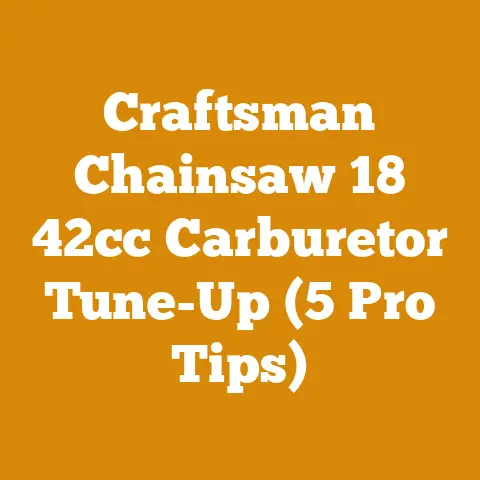Stihl MS 170 Replacement Chain Tips (5 Pro Cutting Hacks)
The Stihl MS 170 is a fantastic little chainsaw, known for its reliability and ease of use. One of the things I appreciate most about it is how simple it is to maintain. And the chain is a crucial part of that maintenance. Keeping your Stihl MS 170 chain sharp and in good condition is essential for safe and efficient cutting. This article will dive deep into replacement chain tips, offering not just instructions, but also pro-level hacks to enhance your chainsaw experience.
Stihl MS 170 Replacement Chain Tips: 5 Pro Cutting Hacks
Replacing the chain on your Stihl MS 170 might seem daunting at first, but with the right knowledge and a few practical tips, it becomes a routine task. I’ve spent years felling trees, bucking logs, and preparing firewood, and I’ve learned a lot about chainsaws along the way. This guide isn’t just about replacing a chain; it’s about maximizing your chainsaw’s performance and extending the life of both the chain and the saw itself.
Understanding Your Chain: Key Concepts
Before we get into the nitty-gritty of replacement, let’s clarify some key concepts. Understanding these will make you a more informed chainsaw user.
- Chain Pitch: This is the distance between three consecutive rivets divided by two. The Stihl MS 170 typically uses a 3/8″ low profile pitch chain. Knowing your pitch is crucial for selecting the correct replacement chain.
- Chain Gauge: This is the thickness of the drive links that fit into the guide bar groove. The MS 170 usually uses a .050″ gauge. Again, matching the gauge is vital for proper chain function.
- Drive Link Count: The number of drive links is essential for chain length. This number will be specific to the length of the bar you are using on your MS 170.
- Green Wood vs. Seasoned Wood: Green wood is freshly cut wood with high moisture content. Seasoned wood has been air-dried and has a significantly lower moisture content. Cutting green wood can dull your chain faster due to the higher resin content.
- Raker (Depth Gauge): The raker controls how much wood each cutter takes. If the rakers are too high, the chain won’t cut aggressively. If they are too low, the chain will grab and can cause kickback.
- Kickback: Kickback is a sudden and dangerous upward or backward movement of the chainsaw. It’s often caused by the tip of the bar hitting a solid object or pinching the chain. Understanding kickback and how to prevent it is paramount for safety.
- Bar Oil: Bar oil is a specialized lubricant designed to keep the chain and bar cool and lubricated. Using the correct bar oil is crucial for preventing premature wear.
Hack #1: Choosing the Right Replacement Chain
Selecting the right replacement chain is the foundation of efficient cutting. Don’t just grab any chain off the shelf.
- Identify Your Needs: Are you primarily cutting softwood (like pine or fir) or hardwood (like oak or maple)? Softwood generally requires a chain with a more aggressive cutting profile, while hardwood benefits from a chain designed for durability.
- Match the Specifications: Ensure the replacement chain matches the pitch, gauge, and drive link count of your original chain. This information is usually stamped on the guide bar or in the owner’s manual. If you’re unsure, take your old chain to a reputable dealer for assistance.
- Consider Low-Kickback Chains: If you’re a beginner, opt for a low-kickback chain. These chains have safety features that reduce the risk of kickback.
-
Chain Types: There are different types of chains, including:
- Full Chisel: These chains have square-cornered cutters for fast, efficient cutting. They are best suited for clean wood and experienced users.
- Semi-Chisel: These chains have rounded-cornered cutters, making them more durable and less prone to dulling in dirty or frozen wood.
- Low-Profile (Micro-Lite): These chains are designed for smaller chainsaws like the MS 170. They offer good cutting performance with reduced kickback.
I have had personal experience where a client switched to a more aggressive chain on their MS 170. While they initially saw faster cutting, the increased wear on the bar and the increased risk of kickback led them back to a standard low-profile chain.
-
Cost vs. Quality: While it’s tempting to save money on a cheaper chain, investing in a high-quality chain will pay off in the long run. A better chain will stay sharper longer, require less frequent sharpening, and ultimately last longer.
Hack #2: Gathering Your Tools and Preparing Your Workspace
Having the right tools and a well-organized workspace will make the chain replacement process smoother and safer.
- Essential Tools:
- Chainsaw Wrench (Scrench): This multi-tool is specifically designed for chainsaws. It typically includes a screwdriver, a socket for the bar nuts, and a tool for adjusting the chain tension.
- Work Gloves: Protect your hands from sharp chain teeth and potential splinters.
- File and Filing Guide: For sharpening the chain after installation.
- Chain Breaker (Optional): Useful for shortening or repairing chains.
- Chain Spinner (Optional): Helps to evenly distribute oil on the chain.
- Small Brush: For cleaning the chainsaw.
- Workspace Preparation:
- Clear the Area: Ensure you have a clean, well-lit workspace free from obstructions.
- Secure the Chainsaw: Place the chainsaw on a stable surface, such as a workbench or a stump. Make sure the chain brake is engaged.
- Gather Your Supplies: Have the replacement chain, tools, and bar oil readily available.
Hack #3: Removing the Old Chain Safely
Removing the old chain requires a careful approach to avoid injury.
- Engage the Chain Brake: Before starting any work on the chainsaw, always engage the chain brake.
- Loosen the Bar Nuts: Use the scrench to loosen the bar nuts that hold the side cover in place. Do not remove them completely yet.
- Adjust the Chain Tension: Use the screwdriver part of the scrench to turn the chain tensioning screw counterclockwise. This will loosen the chain, making it easier to remove.
- Remove the Side Cover: Once the chain is loose, remove the bar nuts and the side cover.
- Remove the Old Chain: Carefully lift the old chain off the guide bar and the drive sprocket. Be mindful of the sharp teeth.
- Inspect the Drive Sprocket: Check the drive sprocket for wear or damage. If the sprocket is worn, it can damage the new chain. Replace it if necessary.
Hack #4: Installing the New Chain Like a Pro
Installing the new chain correctly is crucial for proper chainsaw operation.
- Position the Guide Bar: Make sure the guide bar is properly seated on the mounting studs.
- Orient the Chain Correctly: The cutting edges of the chain should point in the direction of chain rotation. This is usually indicated by an arrow on the chain or the guide bar. If you install the chain backward, it won’t cut.
- Place the Chain on the Guide Bar: Starting at the top of the guide bar, carefully place the chain around the bar groove, ensuring that the drive links are seated in the groove.
- Position the Chain on the Drive Sprocket: Align the chain with the drive sprocket and ensure that the drive links engage with the sprocket teeth.
- Reinstall the Side Cover: Place the side cover back on the chainsaw, making sure the guide bar studs align with the holes in the cover.
- Tighten the Bar Nuts: Tighten the bar nuts finger-tight.
- Adjust the Chain Tension: Use the screwdriver part of the scrench to adjust the chain tension. The chain should be snug against the guide bar but still able to be pulled around the bar by hand. A good rule of thumb is to pull the chain away from the bar at the midpoint. You should be able to see about half of the drive links.
- Final Tighten: Once the chain tension is properly adjusted, fully tighten the bar nuts.
Hack #5: Post-Installation Checks and Maintenance
After installing the new chain, perform these checks and maintenance steps to ensure optimal performance and longevity.
- Check Chain Tension Again: After running the chainsaw for a few minutes, stop the engine and check the chain tension again. New chains tend to stretch slightly during initial use.
- Lubricate the Chain: Fill the bar oil reservoir with high-quality bar oil. Ensure that the oiler is functioning properly and that the chain is receiving adequate lubrication.
- Sharpen the Chain: A sharp chain is a safe chain. Use a file and filing guide to sharpen the chain regularly. Maintain the correct filing angle and depth gauge setting.
- Clean the Chainsaw: After each use, clean the chainsaw to remove sawdust and debris. Pay particular attention to the guide bar groove and the chain oiler.
- Store the Chainsaw Properly: Store the chainsaw in a dry, safe place. Consider using a bar cover to protect the chain and prevent accidental cuts.
Chain Sharpening: A Deeper Dive
Maintaining a sharp chain is crucial for safety, efficiency, and the longevity of your chainsaw. Here’s a more detailed look at chain sharpening:
- Tools for Sharpening:
- Round File: The correct size round file for your chain’s cutter size.
- Flat File: For filing the depth gauges (rakers).
- Filing Guide: Helps maintain the correct filing angle and depth.
- Depth Gauge Tool: A specialized tool for setting the depth gauges.
- Vise (Optional): A vise can help hold the guide bar steady during sharpening.
- Sharpening Procedure:
- Secure the Guide Bar: If using a vise, secure the guide bar in the vise.
- Locate the Sharpest Cutter: Start with the cutter that appears to be the sharpest. This will serve as your reference for the other cutters.
- Position the File: Place the round file in the cutter, using the filing guide to maintain the correct angle. The filing angle is usually indicated on the filing guide.
- File the Cutter: Push the file through the cutter in a smooth, controlled motion. File only in one direction. Repeat this process several times until the cutter is sharp.
- Sharpen All Cutters: Sharpen all the cutters on the chain, using the first cutter as your reference. Ensure that all cutters are sharpened to the same length and angle.
- File the Depth Gauges (Rakers): Use the flat file and depth gauge tool to file the depth gauges. The depth gauges should be slightly lower than the cutters. The correct depth gauge setting is usually indicated on the depth gauge tool.
- Test the Chain: After sharpening, test the chain by making a few cuts. A properly sharpened chain should cut smoothly and efficiently.
Troubleshooting Common Chain Problems
Even with proper maintenance, you may encounter some common chain problems. Here’s how to troubleshoot them:
- Chain Won’t Cut:
- Dull Chain: The most common cause. Sharpen the chain.
- Incorrect Depth Gauge Setting: The depth gauges may be too high. File the depth gauges.
- Chain Installed Backward: Ensure the chain is installed with the cutting edges pointing in the direction of rotation.
- Chain Binds or Jumps:
- Loose Chain: Adjust the chain tension.
- Worn Guide Bar: Replace the guide bar.
- Worn Drive Sprocket: Replace the drive sprocket.
- Chain Breaks Frequently:
- Incorrect Chain Tension: Adjust the chain tension.
- Insufficient Lubrication: Ensure the oiler is functioning properly and that the chain is receiving adequate lubrication.
- Damaged Chain: Replace the chain.
- Chain Smokes:
- Insufficient Lubrication: Check the bar oil level and ensure the oiler is functioning properly.
- Dull Chain: A dull chain requires more force to cut, which can generate heat and smoke. Sharpen the chain.
- Uneven Cutting:
- Unevenly Sharpened Chain: Ensure that all cutters are sharpened to the same length and angle.
- Worn Guide Bar: Replace the guide bar.
Case Study: Reviving an Old Stihl MS 170
I once encountered a neglected Stihl MS 170 that had been sitting unused for years. The chain was rusty, dull, and the bar was covered in dried sap. The owner was about to throw it away, but I offered to take a look.
Here’s what I did:
- Disassembly and Cleaning: I carefully disassembled the chainsaw, removing the chain, guide bar, and side cover. I cleaned all the parts with a solvent to remove the accumulated dirt, sap, and rust.
- Chain Assessment: The chain was too far gone to be sharpened effectively. I replaced it with a new Stihl low-profile chain.
- Guide Bar Refurbishment: The guide bar had some minor burrs and wear. I used a flat file to remove the burrs and smooth out the bar rails. I also cleaned the oil holes to ensure proper lubrication.
- Sprocket Inspection: The drive sprocket was in good condition, so I simply cleaned it thoroughly.
- Reassembly and Lubrication: I reassembled the chainsaw, ensuring that the chain was properly tensioned and lubricated.
- Tuning and Testing: I adjusted the carburetor settings to ensure the engine was running smoothly. I then tested the chainsaw by cutting some small logs.
The result was a revived Stihl MS 170 that performed like new. This case study highlights the importance of proper maintenance and the potential for restoring even neglected chainsaws with a little effort and the right techniques.
Safety First: Essential Precautions
Chainsaw safety is paramount. Always follow these precautions:
- Personal Protective Equipment (PPE): Wear appropriate PPE, including:
- Chainsaw Chaps: To protect your legs from cuts.
- Safety Glasses or Face Shield: To protect your eyes from flying debris.
- Hearing Protection: Chainsaws are loud and can cause hearing damage.
- Gloves: To protect your hands.
- Steel-Toed Boots: To protect your feet.
- Read the Owner’s Manual: Familiarize yourself with the chainsaw’s operating instructions and safety features.
- Inspect the Chainsaw: Before each use, inspect the chainsaw for any damage or loose parts.
- Start the Chainsaw Safely: Start the chainsaw on the ground, with the chain brake engaged.
- Maintain a Firm Grip: Always hold the chainsaw with both hands, keeping a firm grip.
- Be Aware of Your Surroundings: Be aware of your surroundings and avoid cutting near obstacles or other people.
- Avoid Cutting Above Shoulder Height: Cutting above shoulder height is dangerous and can lead to loss of control.
- Never Cut with a Dull Chain: A dull chain is more likely to kick back.
- Be Aware of Kickback: Understand the causes of kickback and how to prevent it.
- Never Use a Chainsaw While Fatigued or Under the Influence: Chainsaw operation requires focus and concentration.
- Store the Chainsaw Safely: Store the chainsaw in a safe place, out of reach of children.
Strategic Insights: Optimizing Your Firewood Preparation
Beyond the technical aspects of chain replacement, consider these strategic insights for optimizing your firewood preparation:
- Gather Your Tools and Supplies: Assemble the necessary tools, including a chainsaw wrench, work gloves, a file, and a filing guide. Purchase a high-quality replacement chain that matches the specifications of your Stihl MS 170.
- Inspect Your Chainsaw: Thoroughly inspect your chainsaw for any damage or loose parts. Pay particular attention to the guide bar, drive sprocket, and chain oiler.
- Practice Chain Replacement: Practice removing and installing the chain a few times to become comfortable with the process.
- Sharpen Your Chain: Learn how to sharpen your chain using a file and filing guide.
- Start Cutting: Once you’re confident in your skills, start cutting firewood or performing other chainsaw tasks.
- Maintain Your Chainsaw Regularly: Regularly clean and lubricate your chainsaw to keep it in good working condition.
- Continue Learning: Stay informed about the latest chainsaw techniques and safety practices. Attend workshops, read articles, and consult with experienced chainsaw users.
Final Thoughts
Mastering chain replacement on your Stihl MS 170 is a skill that will save you time, money, and frustration. By following the tips and techniques outlined in this guide, you can keep your chainsaw running smoothly and efficiently for years to come. Remember to prioritize safety and always use the appropriate PPE. With practice and dedication, you’ll become a chainsaw pro in no time.






